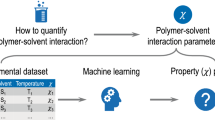Abstract
Various methods of structure determination for liquids are considered. It is shown that the most fruitful technique is using the distribution functions. This is the only technique providing the calculation of the thermodynamic parameters of a liquid from the functions found in a numerical experiment.
Similar content being viewed by others
REFERENCES
N. N. Bogolyubov, Problems of Dynamic Theory in Statistical Physics [in Russian], Vol. 2, Naukova Dumka, Kiev (1970), p. 99.
G. A. Martynov, Classical Statistical Mechanics, Kluwer, Dordrecht (1997).
G. A. Martynov, Usp. Fiz. Nauk, 166, No. 10, 1105–1132 (1996).
G. A. Martynov, Teor. Mat. Fiz., 22, No. 1, 85–96 (1975).
G. A. Martynov, in: Fundamental Theory of Liquids, A. Hilger (ed.), Bristol (1992).
G. A. Martynov, J. Phys. Chem., 74, Suppl. 1, 149 (2000).
G. A. Martynov and G. N. Sarkisov, Phys. Rev., B42, No. 4, 2504 (1990).
G. A. Martynov, Teor. Mat. Fiz., 123, No. 3, 500 (2000).
Author information
Authors and Affiliations
Rights and permissions
About this article
Cite this article
Martynov, G.A. What Is the Structure of a Liquid?. Journal of Structural Chemistry 43, 507–514 (2002). https://doi.org/10.1023/A:1020305620058
Issue Date:
DOI: https://doi.org/10.1023/A:1020305620058




